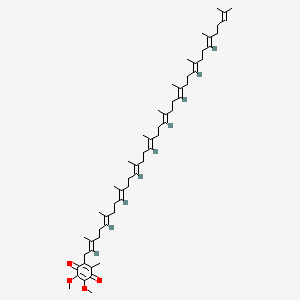| MeSH term | MeSH ID | Detail |
|---|---|---|
| Body Weight | D001835 | 333 associated lipids |
| Diabetes Mellitus, Type 2 | D003924 | 87 associated lipids |
| Peripheral Nervous System Diseases | D010523 | 33 associated lipids |
| Sciatic Neuropathy | D020426 | 13 associated lipids |
| Proteostasis Deficiencies | D057165 | 5 associated lipids |
| MELAS Syndrome | D017241 | 3 associated lipids |
| Neglected Diseases | D058069 | 3 associated lipids |
| Rare Diseases | D035583 | 2 associated lipids |
Coenzyme Q10
Coenzyme q10 is a lipid of Prenol Lipids (PR) class. Coenzyme q10 is associated with abnormalities such as Nephrotic Syndrome, Diabetes, COENZYME Q10 DEFICIENCY, Deafness and Hypertensive disease. The involved functions are known as Mutation, Process, Oxidation, Electron Transport and Oxidants. Coenzyme q10 often locates in Mitochondria, soluble, Plasma membrane, Body tissue and Inner mitochondrial membrane. The associated genes with Coenzyme Q10 are MT-CYB gene, ATP5B gene, cytochrome c'', STN gene and NPC1 gene. The related lipids are Total cholesterol and Lipid Peroxides. The related experimental models are Mouse Model.
Cross Reference
Introduction
To understand associated biological information of Coenzyme Q10, we collected biological information of abnormalities, associated pathways, cellular/molecular locations, biological functions, related genes/proteins, lipids and common seen animal/experimental models with organized paragraphs from literatures.
What diseases are associated with Coenzyme Q10?
Coenzyme Q10 is suspected in Heart failure, Myocardial Ischemia, COENZYME Q10 DEFICIENCY, Neurodegenerative Disorders, Myocardial Infarction, Glaucoma and other diseases in descending order of the highest number of associated sentences.
Related references are mostly published in these journals:
- Invest. Ophthalmol. Vis. Sci. (2)
- Proc. Natl. Acad. Sci. U.S.A. (1)
- Am. J. Epidemiol. (1)
- Others (7)
| Disease | Cross reference | Weighted score | Related literature |
|---|
Possible diseases from mapped MeSH terms on references
We collected disease MeSH terms mapped to the references associated with Coenzyme Q10
PubChem Associated disorders and diseases
What pathways are associated with Coenzyme Q10
There are no associated biomedical information in the current reference collection.
PubChem Biomolecular Interactions and Pathways
Link to PubChem Biomolecular Interactions and PathwaysWhat cellular locations are associated with Coenzyme Q10?
Visualization in cellular structure
Associated locations are in red color. Not associated locations are in black.
Related references are published most in these journals:
| Location | Cross reference | Weighted score | Related literatures |
|---|
What functions are associated with Coenzyme Q10?
Related references are published most in these journals:
| Function | Cross reference | Weighted score | Related literatures |
|---|
What lipids are associated with Coenzyme Q10?
Related references are published most in these journals:
| Lipid concept | Cross reference | Weighted score | Related literatures |
|---|
What genes are associated with Coenzyme Q10?
Related references are published most in these journals:
| Gene | Cross reference | Weighted score | Related literatures |
|---|
What common seen animal models are associated with Coenzyme Q10?
Mouse Model
Mouse Model are used in the study 'Coenzyme Q10 instilled as eye drops on the cornea reaches the retina and protects retinal layers from apoptosis in a mouse model of kainate-induced retinal damage.' (Lulli M et al., 2012).
Related references are published most in these journals:
| Model | Cross reference | Weighted score | Related literatures |
|---|
NCBI Entrez Crosslinks
All references with Coenzyme Q10
Download all related citations| Authors | Title | Published | Journal | PubMed Link |
|---|---|---|---|---|
| Grimaldi S et al. | QH*- ubisemiquinone radical in the bo3-type ubiquinol oxidase studied by pulsed electron paramagnetic resonance and hyperfine sublevel correlation spectroscopy. | 2001 | Biochemistry | pmid:11170426 |
| Hartmann MA et al. | Metabolism of farnesyl diphosphate in tobacco BY-2 cells treated with squalestatin. | 2000 | Biochem. Soc. Trans. | pmid:11171211 |
| Echtay KS et al. | Uncoupling proteins 2 and 3 are highly active H(+) transporters and highly nucleotide sensitive when activated by coenzyme Q (ubiquinone). | 2001 | Proc. Natl. Acad. Sci. U.S.A. | pmid:11171965 |
| Sato S et al. | [A case of intractable intrahepatic cholestasis treated with coenzyme Q10 (ubidecarenone)]. | 2000 | Nihon Shokakibyo Gakkai Zasshi | pmid:11193494 |
| Singh RB and Niaz MA | Genetic variation and nutrition in relation to coronary artery disease. | 1999 | J Assoc Physicians India | pmid:11225222 |
| Villalba JM and Navas P | Plasma membrane redox system in the control of stress-induced apoptosis. | 2000 | Antioxid. Redox Signal. | pmid:11229527 |
| Arroyo A et al. | NADH and NADPH-dependent reduction of coenzyme Q at the plasma membrane. | 2000 | Antioxid. Redox Signal. | pmid:11229530 |
| Fernández-Ayala DJ et al. | Coenzyme Q protects cells against serum withdrawal-induced apoptosis by inhibition of ceramide release and caspase-3 activation. | 2000 | Antioxid. Redox Signal. | pmid:11229531 |
| Schneider D and Elstner EF | Coenzyme Q10, vitamin E, and dihydrothioctic acid cooperatively prevent diene conjugation in isolated low-density lipoprotein. | 2000 | Antioxid. Redox Signal. | pmid:11229536 |
| pmid:11248707 |
